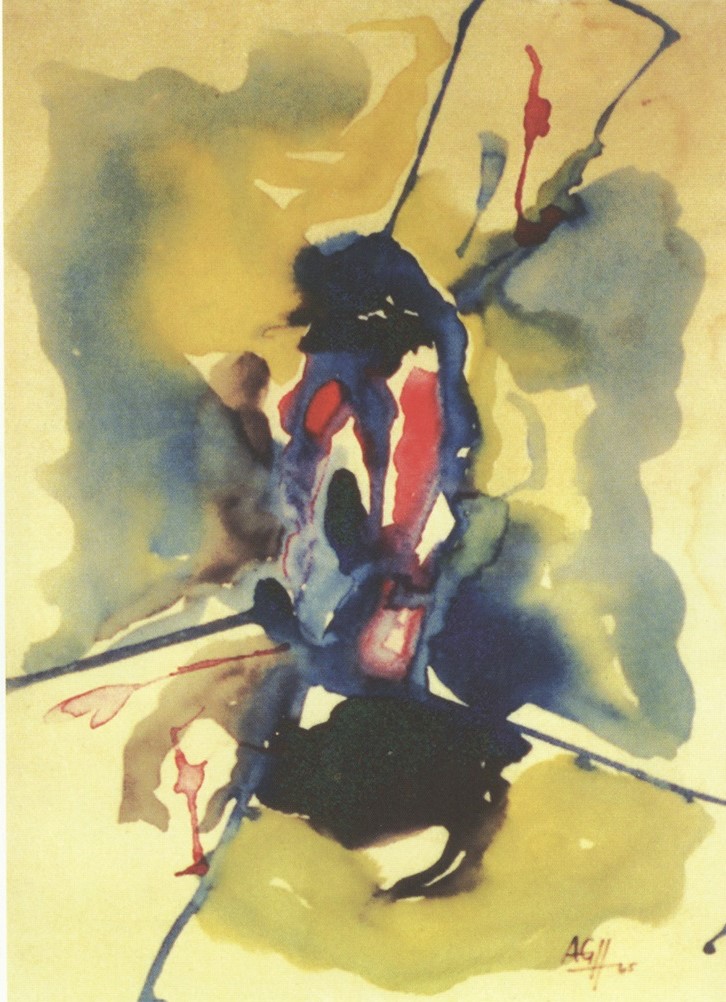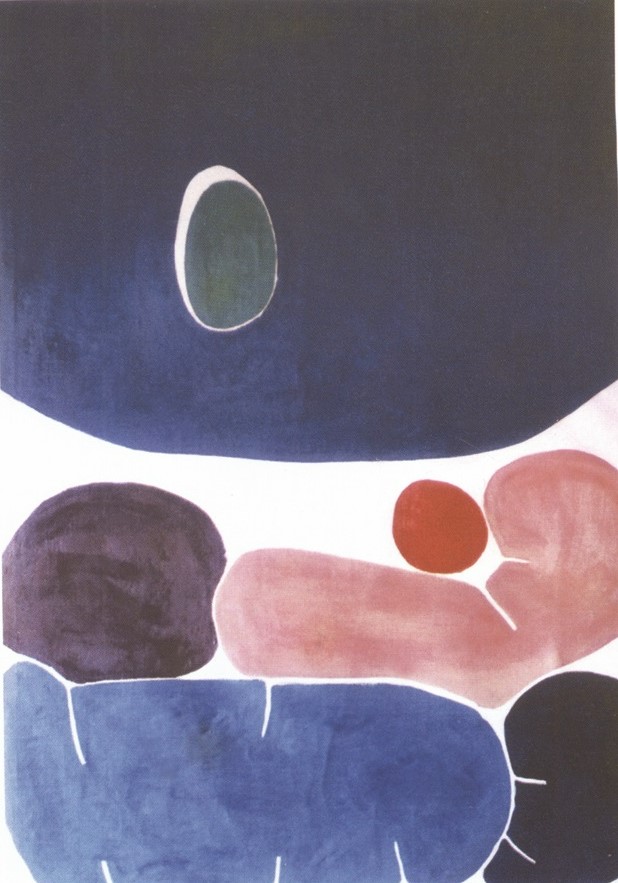Portrait of Poetry in Art
The artist-cum-poet Abdul Ghani Hamid is one of the earliest proponents of Pablo Picasso in the region. He is well known for his controversial artwork in 1957 which he named Mata dan Hati, meaning “Eyes and Heart”.

Abdul Ghani Hamid is one of the authors featured in the Singapore Literary Pioneers Gallery in the National Library, Level 11. Images reproduced from Abdul Ghani Hamid, Petikan Rasa = Abstract of Feelings: A Collection of Poems & Paintings. Angkatan Sasterawan '50.
Modern art started with a movement that developed in stages and it was formed through interactions with various influences that shaped the world. These influences include Paul Cezanne’s works which literally witnessed the breaking down of the world into various cubical forms such as the cylinder, cone and sphere. This approach led to the evolution of the 20th century movement in art, especially paintings with objects represented as geometrical shapes. Apart from this, there were also works by Henri de Toulouse-Lautrec, Diego Velazquez and El Greco, which later inspired Pablo Picasso to propagate a contemporary piece of painting in 1907. This painting inspired by human images in various erotic and cynical perspectives was so artistically innovative that it became a trend setter and subsequently revolutionized the art of painting forever. This mesmerizing piece of painting is Les Dernoiseau d’Avignon.
In 1937, Picasso produced a monochrome based oil painting entitled Guernica. It portrayed horrific images of dismembered humans and animals parts arranged geometrically. Basically, one can find a human body, a cow’s head or a horse leg scattered all over the painting in confusion. This horrific form of painting, as it may seem, was intentionally crafted, so much so that it remains esthetically refreshing in the eyes and minds of paintings enthusiast. They admired the painting with bountiful of praise as being a brave form of art. It was described as the most powerful anti-war sentiments and was the centre piece for the Spanish Pavilion of the 1937 World’s Fair.
Picasso’s inspiration was very much influenced by his interactions with his surroundings and his own experiences in a country that was estranged with hardships, social and political turmoil as result of War. Picasso has indeed expanded the concept of cubism which is a form of art that portray an object in a particular geometric form.
Abdul Ghani Hamid The Artist
Abdul Ghani Hamid is one of the earliest proponents of Pablo Picasso in this region. He is well known for his creation of a controversial art piece in 1957 which he named Mata dan Hati (1975), which means “Eyes and Heart”. The painting drew much polemical debates which lasted for several years. It portrays a synthesis of human organs, cosmos and animates forms transcended aesthetically into the various geometric elements of cube, cone and sphere.

Abdul Ghani is also an established pure abstract artist. One of his earlier works. The Search (1965) was exhibited in 14 cities in Asia together with other artists in Asia. Among his recent works produced are Rasa I, Rasa II and Rasa III which mean “Feeling I”, “Feeling II” and “Feeling III” respectively.
Abdul Ghani Hamid The Poet
Abdul Ghani Hamid is as much a poet as he is an artist. He is also well known for his poetry which is very much associated to the environment. Abdul Ghani is able to complement the existence of colours and shapes to comprehend the environment and his inner energy. Thus, there is poetry for every painting which Abdul Ghani tried, as much as possible, to have matched in harmony.
Being the only Malay artist cum poet in Singapore, he has indeed made his presence felt in this arena by blowing the soul in his poetry into the physical forum and colours in his paintings. The discussion that follows will show how Abdul Ghani merges the two genres namely art and poetry together into a complete anthestic form. Ultimately, the painting is no longer a splurge of colours and forms on a piece of canvas but a living nostalgia which further enhances his deepest innate feelings. The concept of colours and forms which manifest in his paintings bring much meaning to his poetry. Thus, he has produced a genre, “poetry-arts” which is fresh and meaningful.

Such feelings are portrayed in the mild form and arrangements found in the painting entitled Billet Doux [Love letters] (1973). It portrays love that longs for a unprecedented response without a beautiful array of words or strong material attraction. This is skilfully reflected in the poetry entitled Ukiran Kasih (Carving of Love). The poetry narrates that true love especially that of a mother is not determined or limited by superficiality as reflected in the following verses:
Not a line
restricts
not a reward
considered
no words most beautiful
colour my reverence
Not a carving everlasting
as a mother and her child.
The Artist and His World
A unique artist who is conscious of his surroundings, Abdul Ghani Harnid never allows the sights of life to pass by unnoticed. The lalang (tall grasses) that was once a common sight in Singapore has become a symbol of inspiration for many of his creative works. He philosophised that the lalang is a symbol of strength, survival, confidence and focused mindset. To him, the lalang has all the human values that are ineffable and meaningful and they inspired him to produce more than one painting on the same subject. They are Lalang (Green), Lalang (V), Lalang (Mini) and Lalang (VI). One of his early lalang series (1980’s) was exhibited in Salon des Artiste Francais, Grand Palais, Paris.

The spirit of the atop can be seen in Lalang (V), where Abdul Ghani painted two red lalang among a bunch of closely packed green and sometimes yellow lalang. This mixture of natural colours simulates the variations and excitement of the life of the lalang. Once in a while, some purple lalang appears in between the slit of the bunch of lalang. The bunch of the lalang then undergoes some form of evolution because the lalang no longer exists in its natural greenery but in a magnitude of shades that may lead to the lalang losing its roots of existence. Its upright form reflects the decision and a common aspiration of the lalang to move forward without a blink and being prepared to accept changes. This is beautifully expressed in his poetry entitled Sesuatu Mengubah Segalanya (Something Changes Everything) as in the following verse:
A quick drastic change
and fast a fearless dash,
based on time, not intelligence.
it ends halfway.
Sometimes, something changes everything.
The poetry above reflects the impact of changes, due to globalisation among others, on human beings who are beginning to lose the value of life in this fast moving world, resulting in the loss of humanity.
Abdul Ghani is also very much influenced by the world around him. The nostalgic moments of his childhood residing in Jalan Hajjah at Siglap Kampung Baru, in a fisherman’s home, with chirpings of birds flying over the roof, created the very sense of synthesis with the environment. The influence of the waves, winds, sky and the dried leaves scattered around his home is vividly portrayed in his paintings and poetry.

Abdul Ghani’s main assets are his eyes and heart. This is proven by his latest series of photographs. The photographs taken seem to have a much more natural aesthetic value than that of a painting. The photograph entitled Gentle Wave, for example, describes the harshness of the wave hitting a rock. The concentrated intense white bubbles leave behind a beautifully shattered glass effect on the sea’s surface. The green background soothes the eye while the darker tone of green signifies the deep waters that look upon the constant hammering of the current on the waves. This is indeed more than a picture. It is a masterpiece because it is a photograph with painting effects. Abdul Ghani’s meticulous eyes and heart has brought about such a union of nature and beauty. This beauty is expertly expressed in the poetry entitled Batu dan Ombak (Stone and Waves) as in the following verse;
White clear sincerity
brought by distant waves
submission without order
freedom spreads everywhere.
Abdul Ghani’s works are able to portray the universe and his thoughts. Whether directly or indirectly, the paintings are a sound manifestation of the poems assigned to them.
This article was first published in Abdul Ghani Hamid’s Petikan Rasa = Abstract of Feelings: A Collection of Poems & Paintings, pp. 16–18, 1SBN 981-05-2833-7, published 2005 by Angkatan Sasterawan ‘50. Call no. RSING q899.281 ABD

National Institute of Education
Nanyang Technological University
REFERENCES
Abdul Ghani Hamid, Breezes: Selected Poems 1973–1978 (Singapore: Solidarity Publisher, 1978). (Call no. RSING 828.995957 ABD
Abdul Ghani Hamid, An Artist’s Note (Singapore: Angkatan Pelukis Aneka Daya, 1991). (Call no. RSING 759.9597 ABD)
Abdul Ghani Hamid, A Journey With No End (Singapore: Perkumpulan Seni, 1998). (Call no: R828.995957 ABD
Catherine Nichols, Pablo Picasso (New York: PowerKids Press, 2006).
Liz Gogerly, Pablo Picasso: Master of Modern Art (London: Hodder Wayland. 2005)
Stephen Bann and William Allen, eds., Interpreting Contemporary Art (London: Reaktion, 1991) (Call no. RART 709.047 INT)

